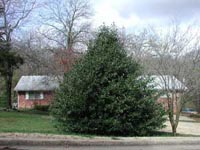Resource Library
Plant of the Week: Nellie R. Stevens Holly
The University of Arkansas System Division of Agriculture does not promote, support or recommend plants featured in "Plant of the Week." Please consult your local Extension office for plants suitable for your region.
Plant of the Week
Nellie R. Stevens Holly
Latin: Ilex x Nellie R. Stevens

Gardens and the plants in them are ephemeral. Here today, gone tomorrow. But sometimes fate intervenes, and new and interesting plants are saved and passed on to future generations.
Nellie R. Stevens holly is such a plant. It was almost ripped out to make way for a garden expansion but was saved by a happy series of events that eventually propelled it into the spotlight as one of the most popular large hollies for southern landscapes.
Nellie R. is the result of a chance interspecific cross between the Chinese holly (Ilex cornuta) and English holly (I. aquifolium). Though the bees were responsible for the pollen dabbing, it was a schoolmarm named Nellie R. Stevens (1866-1942) from Oxford, Md., who filched a few berries on a visit to the U.S. Botanic Garden in Washington, D.C. This fateful trip was in the fall of 1900, but the plant was not known outside the family until 1952 when Nellie’s niece decided it was time to remodel the garden.
Nellie R. Stevens holly is a big, pyramidal plant capable of reaching 25 feet high when mature. It has dark green, 2½-inch long foliage with two or three blunt spines on each side of the leaf. In the fall, it has a respectable display of red, pea-sized berries.
Berry set appears to be parthenocarpically - berries without the benefit of male pollination. This trait is common in Chinese hollies but not in the English holly parent. A male clone, ‘Edward J. Stevens’ was also named from the seeds Miss Nellie planted, but the male form is seldom seen in the nursery trade and does not seem to be critical for berry set. Edward J. was Miss Nellie’s father.
The holly was saved because Eunice Highley, Miss Nellie’s niece and owner of the home where she planted the holly seeds, attended a meeting of the Talbot County Garden Club where the program just happened to be on hollies. The speaker, Gus Van Lennep of nearby St. Michael, MD, was invited to come see the hollies and try to identify them. He couldn’t, and when experts with the America Holly Society couldn’t either, they realized they had a new kind of plant on their hands.
Highley finally decided to preserve the plants, and the annual meeting of the Holly Society met there in 2000 to commemorate the 100th year anniversary of the seeds being planted.
The story of the Nellie R. Stevens holly is told in an interesting book entitled Legends of the Gardens, but subtitled "Who in the World is Nellie Stevens?" This delightful little book, authored by Linda Copeland and Allan Armitage and published in 2001 by Wings Publishers in Atlanta, Ga, tells the personal stories associated with a number of garden plants that were christened with the names of real gardeners.
Just as gardens are ephemeral, so are the stories of how new plants are discovered and developed. By their very nature, gardens are personal spaces preserving and displaying all manner of plants. The stories associated with the plants a gardener chooses to grow, especially if they have a personal connection to the gardener, are one of the best features of any garden.
The popularity of Nellie R. Stevens holly is due to its wide adaptability and ease of growth. It grows in sun or light shade where it doesn’t flinch at poor soils, drought or general neglect. Nellie R. is useful for screening or can be used as a stand-alone specimen.
A planting on the U of A campus in Fayetteville is now eight years old and plants are 8 feet tall and developing the squatty, but upright, look they display. Like all hollies, this shrub is easy to control by shearing. If it becomes overgrown, it can be cut back severely, but really hard pruning should be delayed until early spring just before new growth begins.
By: Gerald Klingaman, retired
Extension Horticulturist - Ornamentals
Extension News - November 19, 2004
The University of Arkansas System Division of Agriculture does not maintain lists of retail outlets where these plants can be purchased. Please check your local nursery or other retail outlets to ask about the availability of these plants for your growing area.